Framestore NY combined live action, 3D characters and real soft drink for ‘Penguin,’ a Pepsi TVC for BBDO New York. Ian Failes talks with Andy Walker (VFX supervisor/CG lead), Murray Butler (VFX supervisor/Flame lead) and Seth Gollub (lead animator) about the spot.
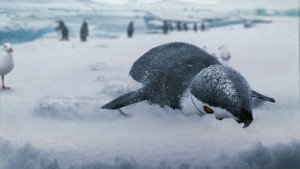 fxg: The spot is so much fun. How did that guide your visual effects and animation process?
fxg: The spot is so much fun. How did that guide your visual effects and animation process?
Andy Walker: It was a strange one in a way because it’s a fairly comical story. That would normally be told quite cartoony in a normal spot. But they wanted to keep it very natural and not go too over the top for the animation. So it involved treading a fine line between cartoon, comedy and realism.
Seth Gollub: Animation-wise, we noticed that after doing our research on penguin motion how naturally cartoony they are. In a way we didn’t really have to exaggerate their movement too much. They’re just so much fun to work with anyway.
Andy Walker: Generally, whatever we did with the penguin, it looked funny. They’re quite comical creatures.
Murray Butler: Yeah, we amped up all the rocket firing stuff to make it funnier as well. I think initially it was less violent, but then we added all the flames and that kind of extreme power to the rocket made it sillier and it worked much better.
fxg: Was the spot storyboarded and prevised?
Andy Walker: It certainly changed a lot!
Murray Butler: We didn’t really have time to previs. We had a storyboard, but that got changed as we were shooting. It evolved a fair bit. There was a sequence where he was going to slide along the snow before he took off. He kind of loses balance and slides along. That all got cut out. But that got cut almost as we were shooting. It was a little bit more improvisational. They built the hut and the interior of the hut, and once the director from Traktor saw the hut, he really loved it. So he shot around the hut really low. Initially that was a much slimmer sequence, and he got really into that after seeing the hut.
Andy Walker: Originally there were a lot more travelling shots too. Flying over a city, for example. It was quite organic with the editor. We were sending through our rough animations and not all of those got used. We probably sent through 50 per cent more shots than were used. The editor cut around and changed the story as we went. So in the end through editorial we had a different spot than what was storyboarded. Through this organic process we were able to hone what we could do in 60 seconds to tell the story.
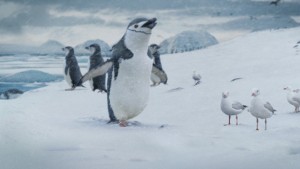 fxg: I can see in the ‘making of’ clip that a lot of the spot started with practical elements. Can you tell me what was shot for real? You shot in Iceland, for example.
fxg: I can see in the ‘making of’ clip that a lot of the spot started with practical elements. Can you tell me what was shot for real? You shot in Iceland, for example.
Murray Butler: Yeah, the Iceland plates were very dramatic. You can see in that clip, though, that the mountains weren’t there and the clouds weren’t there. There was snow there of course, but we added a lot more. So for the Iceland shoot, we shot backgrounds and bits of interaction in the lagoon where we threw things in. It was really good to be able to go into the snow and throw things and make it all work practically.
All the live-action penguins – you can see them in that clip as greenscreen sections – are basically one penguin just in lots of different positions that we used whenever the penguins are there for dressing and not doing anything too specific. The ones that are CG are the ones that are diving in the water or walking.
Andy Walker: They were shot in Texas at an animal sanctuary.
Murray Butler: And all the seagulls were shot separately. They had very specific requirements about the gulls. The gulls were a lot more of big deal than you maybe realise watching it. They needed to help tell the story of the penguin wanting to fly and he needed to watch them. You needed to get the feeling that he wanted to do what they’re doing. We didn’t know what angles would end up being used in the edit, so we actually did two shoots of seagulls afterwards so we could position them in the right way so that our 3D penguin could look at them and react.
Andy Walker: We also shot the swimming pool sequence in Orange County.
Murray Butler: And in the studio we also shot various flame and rocket jet elements, and blown snow on black.
Andy Walker: And the hut was built on bluescreen. The hut was built full-size. We could walk inside that.
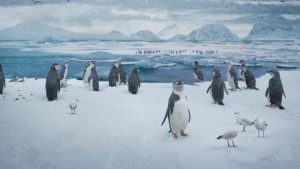 fxg: I think that’s what I really like about the spot – that it’s not entirely CG and there’s a starting point with the effects.
fxg: I think that’s what I really like about the spot – that it’s not entirely CG and there’s a starting point with the effects.
Andy Walker: There was a big mixture of elements. It certainly pulls all the skills in. There’s interaction, weather changes, sky replacements, background replacements, CG penguins, real penguins.
Murray Butler: I totally agree, if you have all those things in the mix, it’s great. Sometimes clients will come to you and say you could use a still, or shoot that in a studio, or use a still of the Antarctic and you add CG snow or you could add CG everything. You have to say yes you could, but somewhere along the line there’s something indefinable – it’s hard to quantify – but the production value in going to these places and shooting tailored elements that are real, when you combine it up the production value – just kind of lifts it. Once everything’s 3D, it’s so much harder to make it feel live.
fxg: How did you create the 3D penguin?
Andy Walker: We started off with a model. We were given reference of the chin strap penguin. We created a generic chin strap penguin. We modified him to look a bit cuter and rounder and more plump. We got a model signed off with a rough colour map on him. Legacy Effects, the former Stan Winston shop, built a physical jet pack. They cast our CG penguin in resin and then mounted the jet pack and hat on him. This enabled the client to look at it and sign off on that.
We did some animation tests on the penguin and developed his movements. How he drank the Pepsi was a big deal. Originally we did it like a penguin eating a fish, which turned out to be a bit extreme. So we went back to more human-like. He kind of grips it in his mouth and you see the Pepsi flowing in. They were really pleased with that.
Then it went into the shoot. Simultaneously with shooting we did all the fur and feather pipeline. We’ve got a lot of tools for fur and feather developed from the polar bears in The Golden Compass and Aslan in the second Narnia film. So we adopted those tools to create the penguin. It was a big animation effort to get him to read as a real penguin, without him looking too cartoony, but performing some human actions and still being penguiny. There was a separate look development for the complexity of the fur. We also modelled the jet pack. It was quite a short turnaround job. I think it was six weeks from shoot to delivery, maybe even just five and a half.
Seth Gollub: For animation, it was such a tight turnaround that we had to evolve quite a lot. Our animation tests which we used for our own research had to be polished up in the end and used as final animation for our background penguins. It was such a quick turnaround that we didn’t have time to do everything from scratch.
fxg: Were there any particular tools you used for the penguin?
Andy Walker: We used Maya as our general 3D tool. Houdini for the smoke effects and particles. We used mental ray for rendering. Shake and Flame for compositing. Then we’ve got a load of proprietary tools for smoke and fur and feathers.
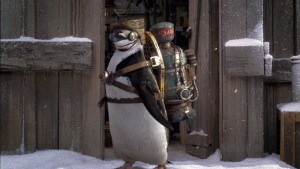 fxg: Can you talk about some of the atmospheric effects in the spot?
fxg: Can you talk about some of the atmospheric effects in the spot?
Andy Walker: There’s a big mixture of live action and 3D. We did an effects shoot in LA that had flames and some smoke elements. We had some snow interaction from Iceland. We also shot some more snow in the studio. That was used generally. You’ll see some of the snow and flame elements have been mixed in. Anything that he was doing specifically, like walking through the snow, they’re CG elements created in Houdini for interaction with the ground. I think there was some sprayed snow as well. A lot of the smoke trail was CG.
Murray Butler: All the big smoke trail shots are a combo of CG and live action. The shot where they’re all looking up – the space shuttle style shot – is actually using some stock footage. It’s a mixture of CG smoke and stock footage of the space shuttle taking off where we lifted some of the smoke and bent it into the right shape. It just had a quality to it that worked really well in the shot.
Andy Walker: The classic NASA take-off.
fxg: What were some of the compositing challenges?
Murray Butler: Almost all of the final compositing was done in Flame. We had Nuke as well for clean-up and bits and pieces. The main challenge was just the sheer volume of layers to finesse in each shot, especially since it was HD. The second shot where you see him on the glacier with all the penguins – it’s just hundreds of layers – the penguins in the foreground, background ones, the gulls, all the shadows, all the interaction elements for each penguin. The management of those and trying to make it look good was definitely a tough job. But everybody’s on the same wavelength in the compositing department here and I’m able to call on juniors or mid-ranking people to pull off nice comps for backgrounds and then I can do the foregrounds.
On the shots where the penguin’s falling over and trying to fly, the toughest thing there was when he’s going towards camera. I was making these focus pulls. We hadn’t shot focus pulls, they were all created in the Flame. You then have to apply the focus pull in a photographic way to all of the gulls and the background layers and all the 3D to make it sit together. That was definitely fiddly to do. But once you get the focus pulls right, it gels everything together nicely and sells the shot.
Andy Walker: It was a blessing and a curse that the opening sequence was really flat snow. It was a blank canvas, but it meant a lot of stuff had to be added to make it feel interesting and epic.
Murray Butler: Another nice thing was that we had to put this snow blowing over everything in these sequences. As a compositor you always want to add those sorts of things because they help bind it all together.
Andy Walker: Yeah, they liven up the shot.
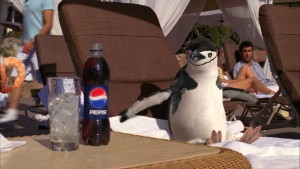 fxg: I love that he’s in the snow and then finds his way into the sun with totally different lighting conditions. How were those shots accomplished?
fxg: I love that he’s in the snow and then finds his way into the sun with totally different lighting conditions. How were those shots accomplished?
Andy Walker: One of the ideas from the start was that the beginning was going to be very flat lighting, very miserable. Then there’d be this transition into sunlight, very happy looking with golden hues everywhere. I think the fact that the original film stock shooting in Iceland on a dull day made it very grainy and miserable and rough. But then shooting in California you get a very crisp image. Also, everything’s graded to look beautiful and vibrant. It was really just following the direction of the footage, in that case.
Murray Butler: I think something that’s impressive about the CGI is the Pepsi bottle itself. Because this is about a product, we thought that we really should shoot it for real because the client’s going to be looking at this bottle and examining every pixel of it. So we thought, ‘Let’s shoot that for real and make our penguin work.’ But Andy was very brave in that we animated the bottle to work with the penguin.
Andy Walker: Yeah, so we shot a Pepsi bottle and just used the liquid on the inside and replaced the bottle and the label. So the Pepsi falling into his mouth is real and the Pepsi in the bottle is real, but the whole bottle is CG wrapped around a real element.
fxg: I think that’s another great example of using real footage and mixing it in.
Andy Walker: Well, the thought of trying to simulate perfect Pepsi with such a tight turnaround, plus having to do the penguin, helped us make that decision. We just thought, ‘Let’s use what we can.’
